State of IT Mind:
The Good, The Bad, and The Future


From Torii CEO and
Co-Founder, Uri Haramati
Executive Summary:
IT professionals face a different landscape today than a few years ago. One that’s full of new and evolving challenges and opportunities—spurred by the onset of digital transformation, remote work, and economic uncertainty. Torii surveyed 200 IT Managers, Directors, VPs, and CIOs to see how they feel about those peaks and troughs and what is top of mind. This report tells the story hiding in the numbers.
It’s a story of optimism and struggles. Opportunities and threats. We found passionate professionals with strong convictions, willing to express their true thoughts on topics like:
• Fulfillment: 99% of IT professionals are proud of their work, and 94% feel appreciated by their company.
• Disagreements: CIOs are far more likely than IT managers to stress about wasted SaaS spending—75% vs 35%
• Application rationalization: only 15% of CIOs believe their organization has a strategic framework in place
Throughout this story, one thing is clear: the future is bright—but it’s not straightforward. Top IT professionals will adapt, collaborate, and succeed in an increasingly complex and distributed workplace.
IT Feels Damn Good
“Nobody ever asks ‘How’s IT?’”
Well, we asked, and we were ready for (justifiably) mixed feelings. After all, times are tough! The SaaS revolution has reshaped human relationships with software and shadow IT; economic instability has triggered widespread layoffs; the tech world faces struggles reminiscent of the 2001 tech bubble burst, and organizations everywhere scramble to curb their tech spend.
So, we asked. How’s IT?
IT’s answer: “Awesome.”
It’s true, across multiple questions and responses, one of the biggest takeaways is that IT teams are not just surviving—but thriving even in the face of uncertainty. They’re proud of their work, appreciated by their company, and optimistic.
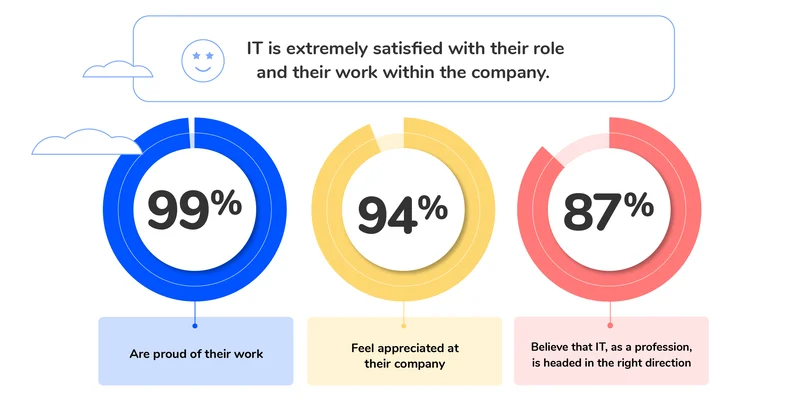
Q: Do you feel proud of your work as an IT professional?
A whopping 99% of IT professionals said they are either “somewhat” or “very” proud of their work as IT pros. This surprising level of positivity was consistent with related questions.
Q: How strongly do you feel that your company appreciates your contributions?
94% of respondents feel “somewhat” or “very strongly” appreciated by their company. And yes, this does differ from the norm. A 2022 survey from Self.inc showed that only 70.8% of U.S. employees said they feel “appreciated by their overall employer.”
Q: To what extent do you agree or disagree with the following statement: IT as a profession is headed in the right direction.
87% of respondents agreed or strongly agreed.
What could be the source of this radiant cheer? It’s true that amidst the changes of the last few years, IT’s role within the company has only grown in importance. We can compare this to an early 2022 study that found 85% of IT professionals said the pandemic increased the visibility of their contributions, but only 38% said it increased their influence within the company.
Are IT and Leadership on the Same Page?
Modern companies lean heavily on IT’s technical prowess. The question we wanted to raise then is, does IT’s importance correspond with influence today? Do they believe their efforts impact the business in a meaningful way?
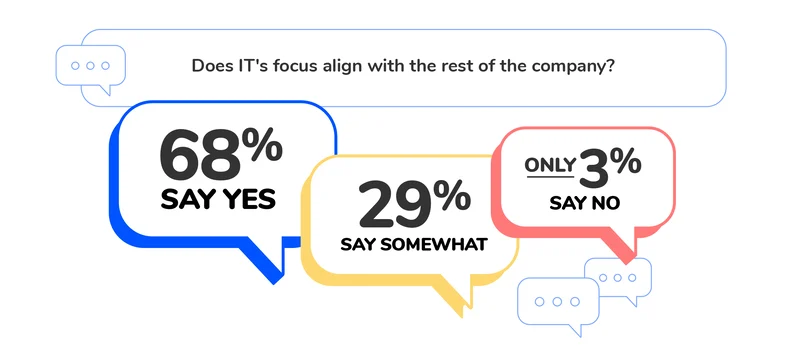
Q: Are your IT team’s focus areas aligned with company priorities?
68% gave a resounding “yes,” while another 29% said “somewhat.” A lonely 3% said “no.” Why do so many feel they’re in lock-step with the business?
The answer is simple—they have a seat at “the table” for matters within their realm of expertise.
For example, we asked:
Q: How included are you in the strategic decision-making process related to the adoption and use of SaaS applications for different business units?
A mammoth 98% of IT pros feel included either “sometimes,” “often,” or “always.” Inclusion, it seems, is the key to harmony and alignment with the company’s priorities. Based on this data, it makes sense to say that IT professionals are now included in the decision-making process. Their inclusion contributes to alignment with the rest of the organization, and that alignment contributes to optimistic IT teams that feel appreciated and valued at their organizations.
Top Threats To Success
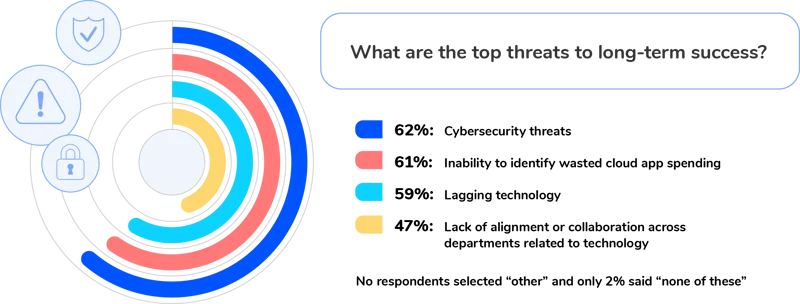
Q: Which of the following pose threats to your company’s long-term success?
At first glance, it appears that Cybersecurity (62%), SaaS spend visibility (61%), and lagging tech (59%) all share the same approximate level of concern. But, we wanted to delve deeper and understand if other factors contribute to the respondents’ answers. Specifically, do the titles of the respondents influence their answers?
SPOILER—yes.
Zooming in on Cloud App Spending
Across titles, most survey answers revealed remarkable unity; from managers to CIOs, we found tight alignment on most responses. But not here. This question showed the survey’s largest difference based on job roles. And interestingly, the higher up the corporate ladder IT pros ascend, the more menacing SaaS spend management challenges become.
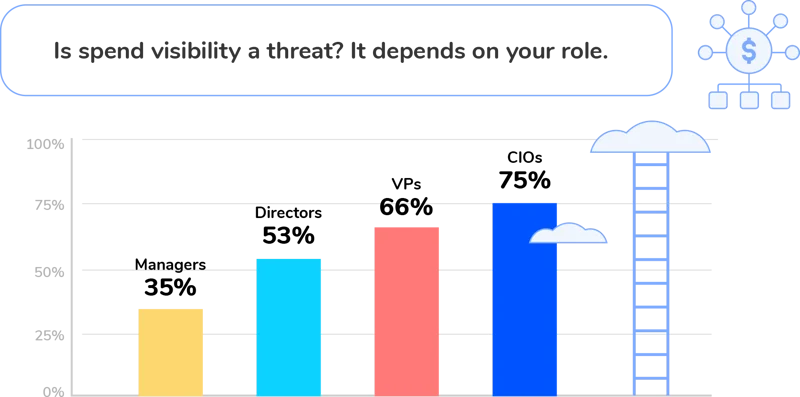
Here are the responses divided by title for those saying SaaS Spend Management is a threat:
35% of Managers
53% of Directors
66% of VPs
75% of CIOs
CIOs are twice as likely to flag “spend” than managers, and almost 50% more than directors.
Historically, IT—from top to bottom—has dubbed cybersecurity their prime threat. As mentioned earlier in this report, a lot has changed, and 2023 shakes things up. For added context, PwC’s annual CEO survey echoes this shift: in 2022, C-suiters named cybersecurity the supreme foe. But, in 2023, like this study reveals, finances and cost reduction became the new boss fight. We’ll dive more into this in Section 3.
What About Alignment and Collaboration?
While CIOs sweat over cash, managers are much more likely to fret about “lack of alignment or collaboration across departments related to technology” (45% for CIOs vs. 72% for Managers). On one hand, this makes sense because they’re in the trenches. However, this higher number caught us by surprise, considering the question from Section One, where 97% of IT pros felt somewhat or fully aligned with the company priorities. This suggests that either other departments are failing to align with company priorities or that collaboration, not alignment, might be the real headache for IT (especially managers).
This finding is similar to Torii’s previous study on cloud app-driven workplace collaboration. That survey exposed that 80% of IT teams infrequently collaborate with other teams. Curious about more graphs and data insights on the collaboration conundrum? Grab the full report.
Why CIOs Stress On Spending
The SaaS spend chasm between managers and C-suite is wide. We wanted to understand the source of these differing opinions. We asked:
Q: Which of the following best describes your organization’s ability to identify wasted SaaS expenses?
Finding cost savings with SaaS is difficult! You have to get visibility, implement a useful framework or process for evaluating applications, and then execute on that plan. In this question, we wanted to understand what part of that process was failing.
We offered five possible responses:
1. We lack visibility
2. We have some visibility, but lack an application rationalization framework
3. We have visibility, an app rationalization framework, but fail in execution
4. We have good visibility, an app rationalization framework, but are inconsistent in execution
5. We have good visibility, an app rationalization framework, and consistently execute
Overall, the vast majority found themselves in either level 2—some visibility but no app rationalization framework (49%), or level 3—visibility and app rationalization framework, but fail in execution (24%). Only 7% said they simply lack visibility, and only 9% were at level 5.
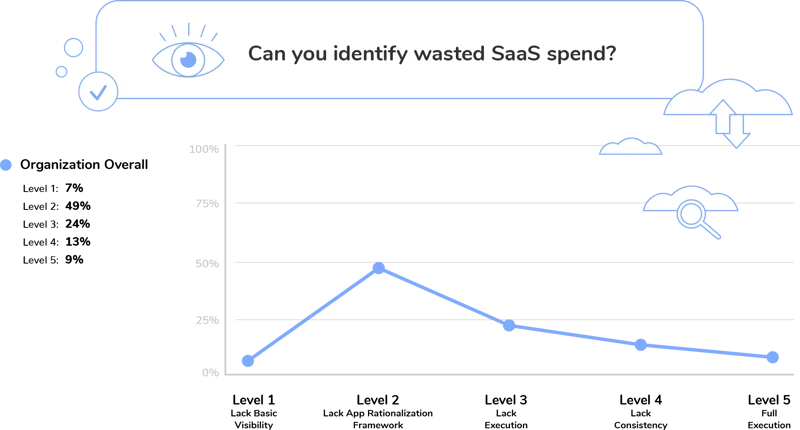
But, as you’ll remember from our previous question, CIOs stressed the most about wasted SaaS spend. We wanted to know how the different roles compared.
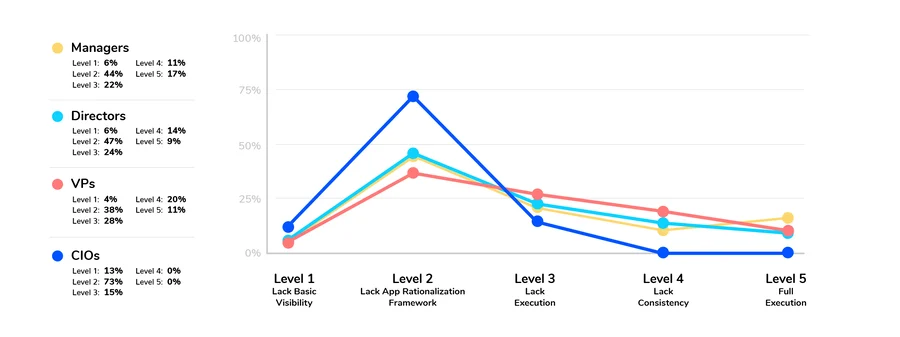
The first thing you’ll notice is the separation between CIOs and the rest of the participants. Not a single CIO gave their organization a grade of level 4 or level 5.
73% of CIOs do not believe their organization has a strategic framework for app rationalization and license usage. 13% say they lack basic visibility.
Compare this with other roles, and we see that VPs, managers, and directors had a slightly more favorable view of their organization’s ability to address wasted spend. However, the overwhelming majority still lacked basic visibility, a framework for success, or consistent execution of those cost-saving measures.
These results paint a picture of IT leadership lacking fundamental capabilities for SaaS spend visibility – and without these insights, it’s impossible to make the right decisions and take the best cost-saving actions.
But where did this disconnect come from? In short—application rationalization.
Application Rationalization is [fill in the blank]
Application rationalization is the art of evaluating an app’s worth against its cost. Companies often struggle to either define a good process or stick to it, so it’s not surprising that a divide between different people in IT organizations emerges here.
Looking at the numbers, only 15% of CIOs rated their organizations as having an application rationalization framework (Level 3-5), whereas higher numbers are found for managers (50%), directors (47%), and VPs (58%).
Why the Stark Divide?
There are two plausible explanations for this difference.
1. Managers, directors, and VPs are not communicating with CIOs about the app rationalization framework in place.
2. These groups and CIOs have different expectations about what app rationalization means. For example, does it require legal approval, specific usage metrics, comparison against similar tools, or input from Infosec or procurement? Perhaps CIOs and managers have different responses to those questions.
In either case, communication between C-suite and lower-level IT pros is the primary breakdown.
Who Cares?
Ignoring the importance of application rationalization can have severe consequences. When done right, it enables IT to evaluate an app’s value – and eliminate those that aren’t valuable, as well as those that have redundant functionality with other apps in their ecosystem. Without a proper framework, businesses risk losing vital apps and carrying expensive yet underutilized and unnecessary ones.
However, if a framework exists but CIOs aren’t aware, it leads to poor decision-making. CIOs rely on available information for strategic choices. If they’re not aware that there’s a process for app rationalization – which by definition would also include ready access to data about app usage, redundancy, and costs – it means they’re making crucial budget and technology decisions with incomplete or false knowledge.
If you’d like clarity about what comprises an application rationalization framework, check out this article: Application Rationalization Made Easy.
IT is Prepared for Cyberthreats (sort of)
Now, all that discord between titles was immediately resolved in the next section. Regardless of role, IT sees cybersecurity as a top threat against which they are comfortably prepared.
Q: Do you feel that your organization correctly understands modern cybersecurity threats?
A colossal 92% confirmed their organization grasps cybersecurity, somewhat or fully. Such confidence begs the question: Why? What fuels this belief in their cybersecurity readiness?
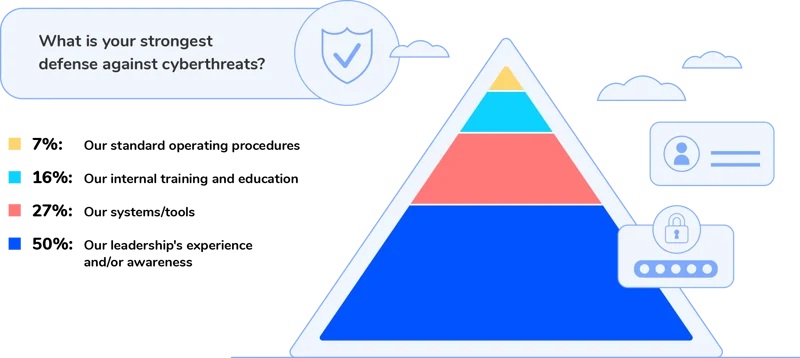
Q: When it comes to cybersecurity preparedness, which aspect of your organization is the strongest?
50% of respondents point to leadership’s cybersecurity experience and awareness. Paired with the 92% confidence rating from the previous question, this tells us that leaders carry a lot of responsibility and trust related to cybersecurity. This raises another question: Does strong leadership ensure strong company security, or does it merely mask underlying issues related to training or procedures?
Only 16% said “internal training and education,” and even fewer, 7%, said their “standard operating procedures” are their strength.
The World Economic Forum highlighted that 95% of cybersecurity incidents stem from human error, i.e., failures of training, education, and standard operating procedures. Yet, despite this glaring vulnerability, numerous organizations remain nonchalant. A Hornet Security study revealed that 33% of companies neglect cybersecurity awareness training for remote workers despite that same study indicating that 74% of remote workers have access to critical data. In today’s remote-first world, this oversight amplifies vulnerabilities.
In short, inadequate training—particularly for remote workers—may be a ticking cyber time bomb, endangering the entire organization.
Reorganize IT? No Thanks
The supposed demise of the centralized IT department has been a circulating story for years, but current professionals aren’t buying it.
Q: With regard to your organizational structure, how centralized are your IT resources?
68% reported operating in a company with a fully or mostly centralized IT department. 27% said there was an even balance between centralized and embedded IT services. Only 6% said IT services were mainly or wholly embedded throughout the rest of the organization.
So that’s their current situation, but what about their opinion of its efficacy? What is the organizational structure that is best for IT?
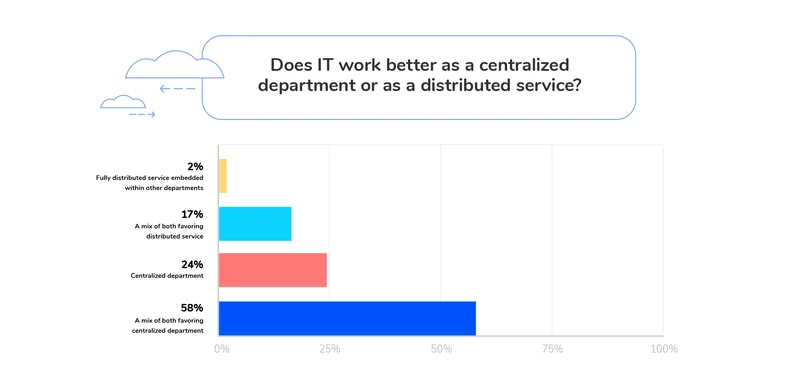
Q: Do you believe IT operates more effectively as a centralized department or as a fully distributed service embedded within other departments?
82% endorsed a wholly or primarily centralized model as best for enabling IT, and that number soared to 90% among CIOs alone. Only 19% thought a more distributed model was best for IT’s efficacy.
Can Centralized IT Scale?
Often the critique of the centralized model is scalability. IT professionals frequently struggle to keep up with the ever-growing task list while feeling “stretched, like butter scraped over too much bread.” The distributed model might represent a strategic response to ease that burden for some.
But what’s the alternative if IT doesn’t believe the solution is embedding IT services throughout the company? Can IT stay centralized while scaling to meet the growing demand for IT services? Can they have their metaphorical cake and eat it too?
IT leaders and managers must ponder the implications of their current structures and anticipate future needs. Adaptation is vital in a rapidly changing tech landscape where end-users often make tech tool decisions and acquire their own apps. Will centralized IT departments persevere, or will emerging technologies and the reality of distributed tech ownership shift toward more decentralized approaches? The answer lies in foresight, adaptability, and continuous reassessment of IT strategies.
Distributed SaaS Management
Returning to our original question, “How is IT doing?”
Pretty good.
However, challenges exist, with more on the horizon. Through complementary Torii studies, we’ve found that many struggles stem from IT’s inability to effectively manage the sprawl of cloud applications, both sanctioned and unsanctioned. The rise and proliferation of SaaS are inevitable, but the associated headaches don’t have to be.
IT leaders eager to address this growing source of pain are exploring new methodologies and strategies to manage SaaS sprawl. Many are turning to Distributed SaaS Management, a robust framework that enhances:
• Central visibility
• Cross-functional collaboration
• Spend management
• Operational efficiency
• Scalability
All without compromising the centralized IT department structure.
Distributed SaaS Management brings other stakeholders, such as procurement, finance, and company-wide application owners, to the SaaS table and allows IT to empower them to help manage SaaS onboarding, offboarding, and spending through thoughtful delegation and automation.
To delve deeper into Distributed SaaS Management, check out the Playbook—a comprehensive four-step action plan designed to help IT pros tackle SaaS challenges head-on.
About the Survey:
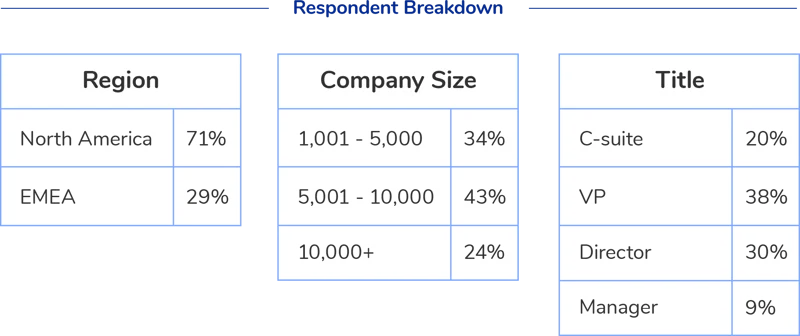
On behalf of Torii, Gartner Peer Community surveyed 200 IT pros: Managers, Directors, VPs, and C-suite (CIOs). All data was cleaned and verified by Gartner’s data analyst team.
In the survey, we probed sentiments, hurdles, expectations, and musings on IT. Questions spanned teams, individuals, and the IT role as a whole.